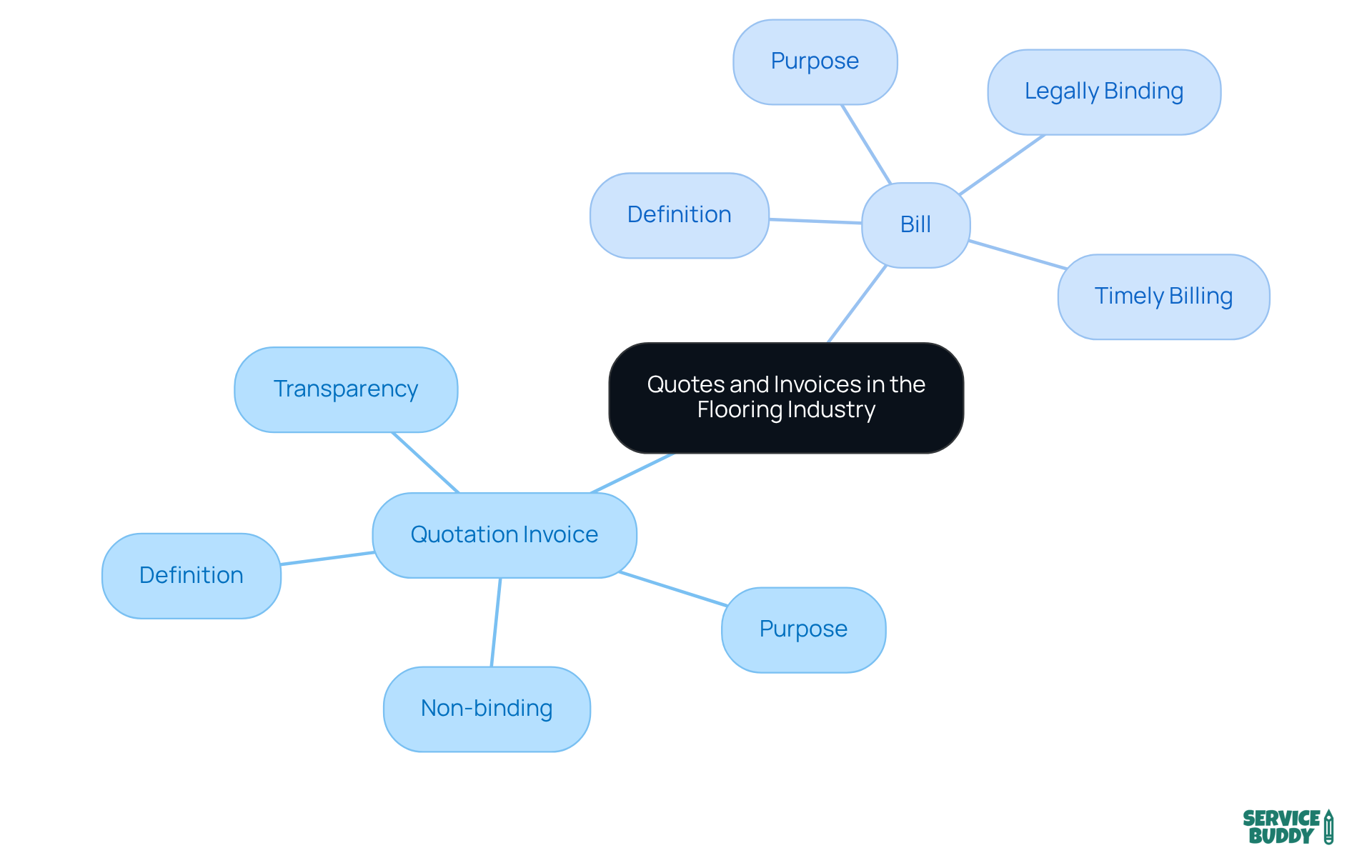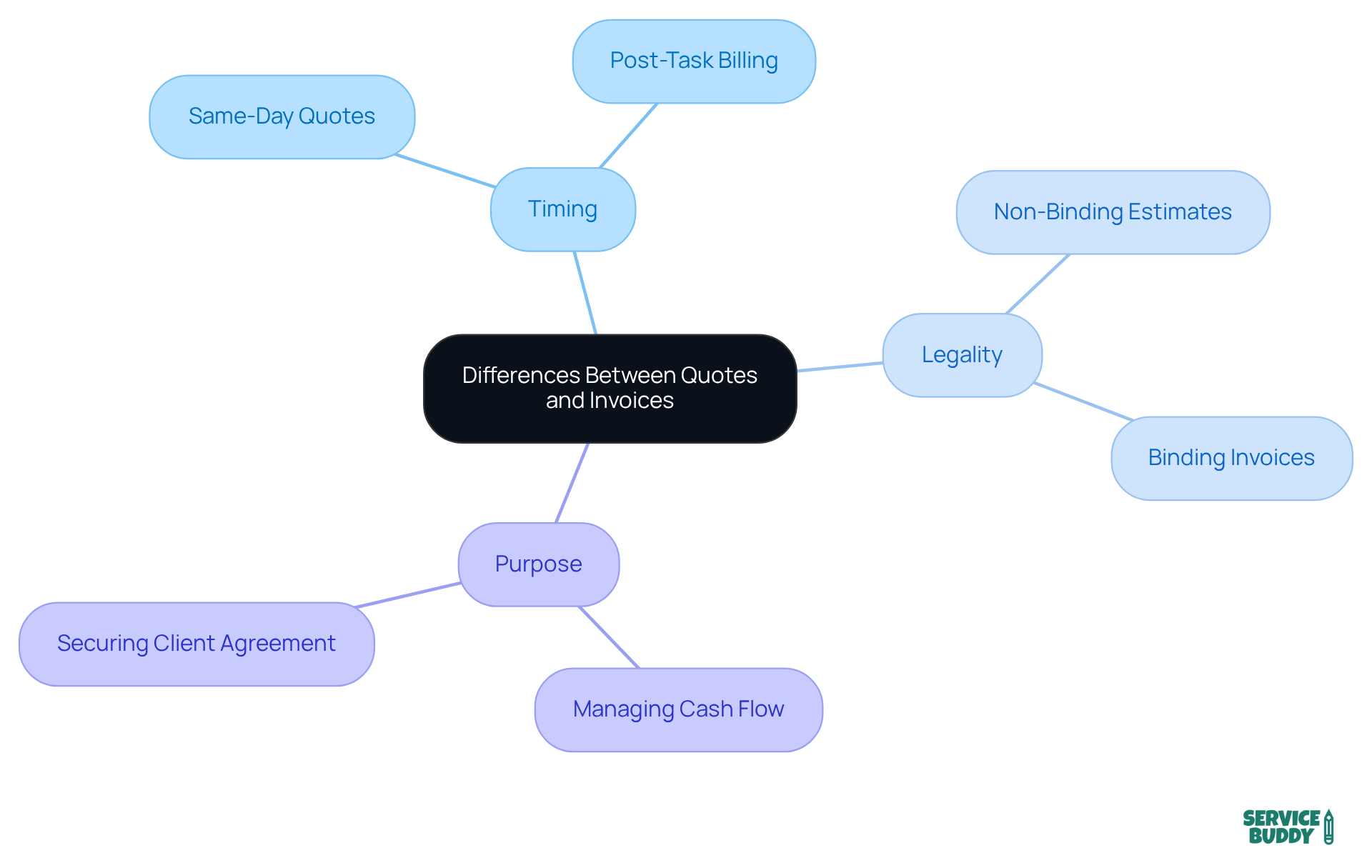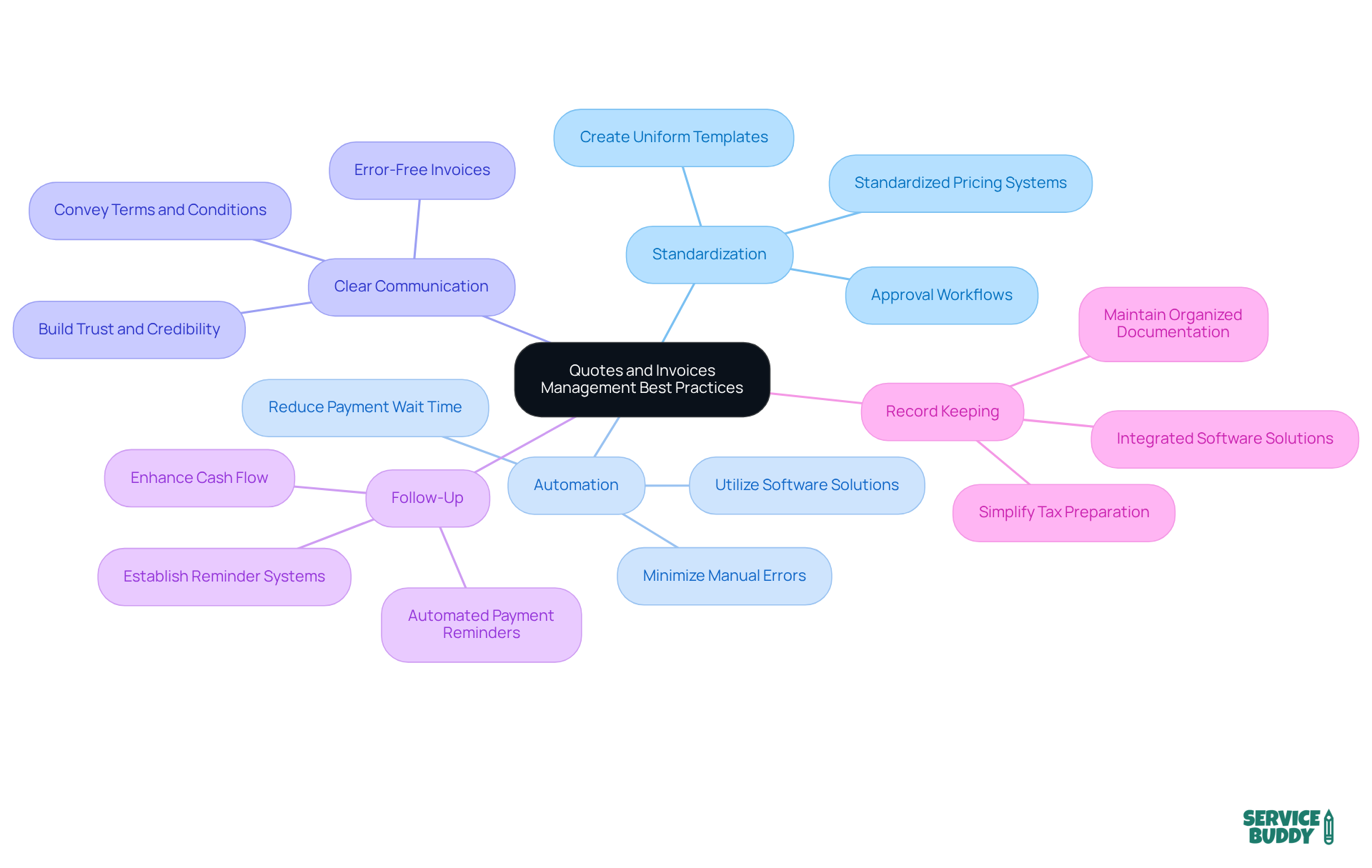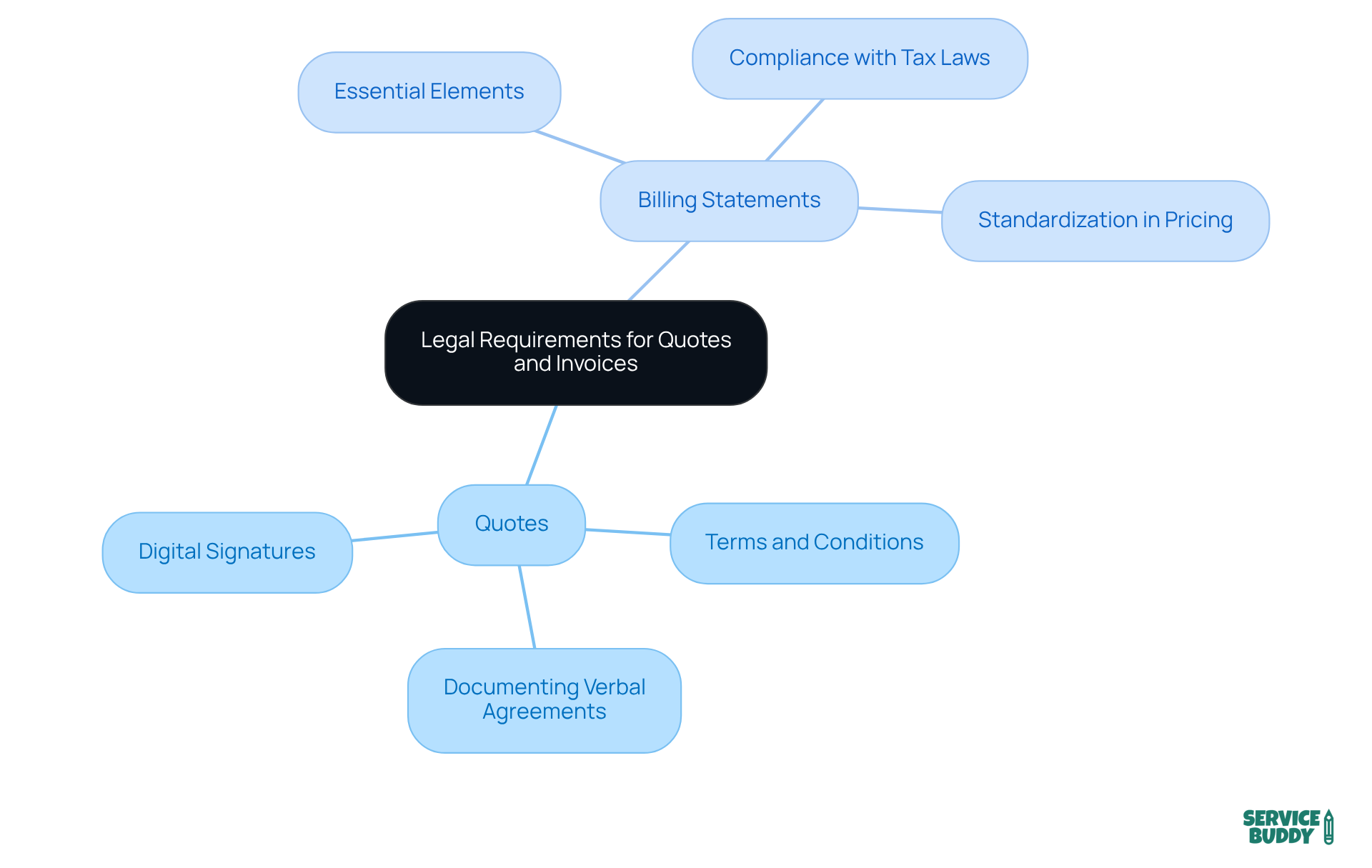Overview
Understanding the key differences between quotation invoices and bills is essential for every flooring business. These distinctions revolve around their purpose, timing, and legal implications. A quotation invoice serves as an estimate of costs and is non-binding, whereas a bill is a legally binding document issued after project completion, demanding payment for the actual costs incurred. This knowledge is vital for effective financial management within the industry. By grasping these concepts, flooring business owners can navigate their operational challenges more efficiently.
Introduction
Understanding the intricate world of financial documentation is essential for flooring businesses aiming to thrive in a competitive market. A clear grasp of quotation invoices and their distinctions from traditional invoices can significantly enhance operational efficiency and client relations. However, many professionals grapple with the nuances of these documents, often leading to confusion and potential financial pitfalls.
What are the key differences that every flooring business must recognize to ensure smooth transactions and maintain healthy cash flow?
Define Quotes and Invoices in the Flooring Industry
In the surface covering sector, a quotation invoice serves as a preliminary document provided to prospective clients prior to the commencement of any work. It delineates the estimated costs associated with a flooring project, which includes a quotation invoice for materials, labor, and any additional services. Typically, quotes are non-binding, allowing for adjustments based on negotiations or changes in project scope. According to FreshBooks, it is imperative that your quotation invoice includes all expected charges, regardless of their size, to ensure transparency and professionalism.
Conversely, a bill represents an official demand for compensation issued upon the completion of a task. It details the actual costs incurred during the project and functions as a legally binding document that obligates the client to remit payment for the services rendered. Timely billing is crucial; ideally, of project completion to mitigate cash flow pressure and ensure prompt payments. Automation tools can streamline this invoicing process, minimizing errors and conserving time.
Understanding these definitions is vital for professionals in the industry. Efficient management of estimates and billing, particularly through the use of a quotation invoice, not only simplifies financial procedures but also enhances communication with customers, ultimately contributing to business growth and sustainability. Furthermore, integrating branding components into financial documents can elevate professionalism, creating a positive impact on clients.

Differentiate Between Quotes and Invoices: Key Distinctions
Understanding the is crucial for flooring experts, as these distinctions significantly influence business activities and cash flow management. Here are the key differences:
- Timing: Quotes should be prepared the same day a customer requests them to maintain momentum, serving as preliminary estimates of potential costs. Conversely, bills are produced following the conclusion of a task, officially requesting compensation for the services provided.
- Legality: While estimates are generally non-binding and can be modified through client negotiations, bills are legally binding documents that require the client to make payment upon receipt. A quotation invoice typically outlines estimated costs, terms, and conditions, providing a framework for the project. In contrast, a bill includes detailed itemizations of actual costs incurred, encompassing labor, materials, and applicable taxes. Key aspects of an invoice must include an invoice number, description of goods/services, and payment due date to ensure clarity and legal compliance.
- Purpose: The primary aim of a statement is to inform the client of potential costs and secure their agreement to proceed with the work. Providing a quote helps avoid unpaid work and defines contract value, which is crucial for managing cash flow. On the other hand, a quotation invoice functions to officially request remuneration for completed services, ensuring that the business receives compensation for its efforts.
Comprehending these differences is essential for businesses in the industry to utilize each document efficiently, thereby improving workflow and guaranteeing prompt compensation. For instance, a flooring contractor who offers a comprehensive estimate before commencing a project can establish clear expectations with the client, minimizing the chances of conflicts later on. Likewise, sending bills swiftly after project conclusion can greatly enhance cash flow, as it enables companies to monitor payments and handle their finances more effectively. Moreover, leveraging software applications for automating the pricing and billing process can improve efficiency and precision in managing these vital documents.

Implement Best Practices for Quotes and Invoices Management
To effectively manage quotes and invoices, flooring businesses should adopt the following best practices:
- Standardization: Create uniform templates for estimates and billing statements to ensure consistency in presentation and information. Standardized pricing systems, including templates and approval workflows, assist in eliminating inconsistent estimates in flooring jobs, thereby upholding professionalism and clarity.
- Automation: Utilize software solutions, such as Service Buddy, to streamline the creation and monitoring of estimates and bills. Automation significantly minimizes manual errors and enhances processes, allowing businesses to save time and focus on growth. Studies indicate that automated invoicing can reduce the average payment wait time from months to just days, thereby improving cash flow.
- Clear Communication: Ensure that all terms, conditions, and costs are clearly conveyed in both quotation invoices and billing statements. A well-prepared and error-free quotation invoice not only ensures the correct amount but also fosters trust and credibility with your clients, reducing misunderstandings and disputes.
- Follow-Up: Establish a reminder system for pending bills to ensure prompt settlements. Automated billing software can set up automatic reminders for clients with outstanding payments, enhancing cash flow and reducing the chances of late payments, which is essential for maintaining operational stability.
- Record Keeping: Maintain well-organized documentation of all estimates and bills for financial and auditing purposes. Integrated software like Floorzap eliminates double entry and streamlines job workflows, aiding in financial analysis and simplifying tax preparation, ensuring compliance and accuracy.
By adopting these best practices, companies in the surface covering industry can significantly enhance their operational efficiency and improve overall financial management, positioning themselves for sustained growth in a competitive market.

Understand Legal Requirements for Quotes and Invoices
In the flooring industry, it is crucial for the quotation invoice and invoices to meet specific legal requirements to be deemed valid documents.
Quotes: Although generally non-binding, quotes should encompass clear terms and conditions, including expiration dates, to prevent misunderstandings. As Jason Wright emphasizes, "Aim for accuracy and precision when preparing your flooring quote." Documenting any verbal agreements in writing is advisable to ensure clarity and mitigate potential disputes. Moreover, incorporating digital signatures and real-time updates can foster trust and expedite approvals.
Billing Statements: Billing statements must contain essential elements such as a unique billing number, the date of issue, a detailed breakdown of services rendered, payment terms, and the seller's contact information. Furthermore, bills must comply with local tax laws, including the relevant tax identification numbers and applicable sales tax. Standardization in pricing contributes to consistency and professionalism in quotation invoices.
Non-compliance with these legal requirements can lead to disputes, delayed payments, and potential legal issues. Vague or inaccurate quotes can adversely affect your business, as noted by Jason Wright, who warns that "if you provide a quote that’s vague or inaccurate, it will hurt your business." Flooring businesses should consult with legal professionals to ensure their documents meet all necessary standards and regulations, thereby safeguarding their operations and enhancing client trust.

Conclusion
Understanding the distinctions between quotation invoices and bills is essential for flooring businesses aiming for operational efficiency and financial clarity. These documents play a pivotal role in managing client relationships and ensuring timely payments, ultimately influencing the overall success of a company. By grasping the nuances of each document, flooring professionals can streamline their processes, enhance communication, and foster trust with clients.
Key arguments presented in the article highlight the importance of timing, legality, and purpose in differentiating quotes from invoices. While quotes serve as preliminary estimates that can be adjusted, invoices act as legally binding requests for payment once services are rendered. Adopting best practices such as standardization, automation, clear communication, and diligent record-keeping can significantly improve the management of these documents, leading to better cash flow and operational stability.
Recognizing the significance of quotes and invoices in the flooring industry is not merely about compliance; it is a strategic approach to ensuring business growth and sustainability. Flooring professionals are encouraged to implement the insights and best practices discussed to optimize their financial transactions and enhance their overall service delivery. By doing so, they can position themselves competitively while building lasting relationships with their clients, ultimately contributing to the long-term success of their business.
Frequently Asked Questions
What is a quotation invoice in the flooring industry?
A quotation invoice is a preliminary document provided to prospective clients before work begins, outlining the estimated costs associated with a flooring project, including materials, labor, and additional services.
Are quotes binding in the flooring industry?
Typically, quotes are non-binding, allowing for adjustments based on negotiations or changes in project scope.
What should be included in a quotation invoice?
A quotation invoice should include all expected charges, regardless of their size, to ensure transparency and professionalism.
What is the difference between a quotation invoice and a bill?
A quotation invoice provides an estimate of costs before work starts, while a bill is an official demand for payment issued after project completion, detailing the actual costs incurred.
When should bills be sent to clients?
Bills should ideally be dispatched within ten days of project completion to mitigate cash flow pressure and ensure prompt payments.
How can automation tools help in the invoicing process?
Automation tools can streamline the invoicing process, minimizing errors and saving time.
Why is understanding quotes and invoices important for flooring professionals?
Understanding these definitions is vital for managing estimates and billing efficiently, enhancing communication with customers, and contributing to business growth and sustainability.
How can branding components affect financial documents in the flooring industry?
Integrating branding components into financial documents can elevate professionalism and create a positive impact on clients.




